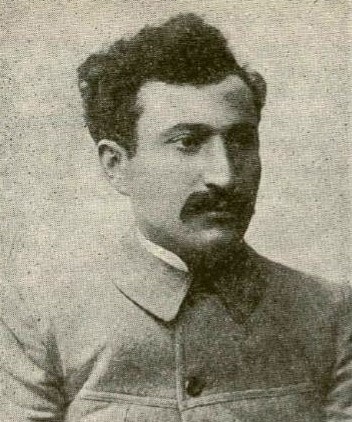| The first years of the twentieth century did not lack in heroic exploits, and Hamazasp Servantzdiants was among those who lived and died in the service of the liberation of his homeland.
Hamazasp Servantzdiants, also known by his first name, was nephew of Bishop Karekin Servantzdiants (1840-1892), the noted ecclesiastic, folklorist and writer. He was born in Van in 1873. After finishing elementary school, he learned and worked as a jeweler and watchmaker.
Soon he was involved in the revolutionary movement, first as a member of the Armenagan Organization, founded in 1885 and mainly active in Van, and then the Armenian Revolutionary Federation. To escape the persecution of Turkish authorities, he left his birthplace and went to Yerevan and Shushi. He participated in the Armeno-Tatar conflict of 1905-1907 and distinguished himself particularly in the bloody combat of Askeran (August 22, 1905).
Hamazasp organized the defense of the Armenians of Gandzak (at the time Elizabetpol, nowadays Ganja) against Tatar incursions. He was arrested during the roundup of A.R.F. members organized by the Czarist government in 1908 and condemned to death. However, his sentence was commuted to a 15-year sentence to forced labor in Siberia. He escaped prison in 1913 and went to Europe, and from there to Constantinople. In August 1914 he participated in the 8 th World Assembly of the A.R.F. and expressed his categorical opposition to any cooperation with the Young Turks.
During World War I, Hamazasp was a key participant in the Armenian volunteer movement as commander of the third battalion of volunteers attached to the Russian army. He participated in many battles on the Caucasian front and ensured that the population of Basen and Alashkert could escape the genocide. In May 1915, he was among the volunteers who liberated the population of Van after a month-long resistance against the attack of the Turkish regular army.
After the first Russian revolution of February 1917, he was appointed commander of the military police of Alashkert and held this post until the Russian withdrawal from the Caucasian battlefront following the October Revolution. He then went to Baku where he fought for the Baku Commune in 1918 as the commander of the Armenian brigade (3,000 soldiers and officers), and then resisted for four months the advance of the Ottoman forces going to Baku. After the fall of Baku to the Turk-Tatar combined forces, he went to Persia.
Returning to Armenia, Hamazasp was designated commander of the forces in the region of Nor Bayazid (nowadays Gavar) and participated in the suppression of the Bolshevik uprising of May 1920 and the Tatar-Turkish revolts. After the establishment of the Soviet regime in December 1920, he was lured to Yerevan by war commissar Avis Nurijanian. Hamazasp went to the capital with the sincere aim of cooperating with the new government. However, it was a trap. He was arrested and threw into prison.
The repressive measures of the Bolshevik regime, headed by the Revolutionary Committee ( Heghgom, in Armenian), proved to be intolerable, and a popular revolt was in the works in mid-February 1921. After twenty-one prisoners were shot to death on the night of February 16-17, several dozens more were shot to death or axed by Turkish butchers on the night of February 17-18. Hamazasp Servantzdiants was among them. On February 18 in the morning, Yerevan was taken by the rebels, the Revolutionary Committee fled, and hundreds of prisoners saved their lives. The same night, the corpses of those dead in the prison of Yerevan were identified and counted. |
